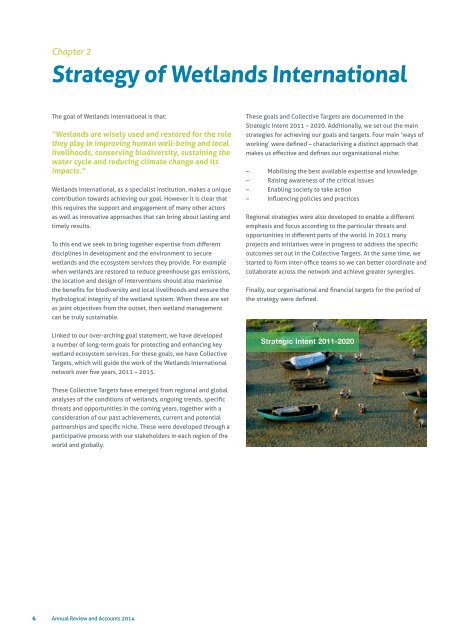Wetlands International
2073fEP
2073fEP
You also want an ePaper? Increase the reach of your titles
YUMPU automatically turns print PDFs into web optimized ePapers that Google loves.
Chapter 2<br />
Strategy of <strong>Wetlands</strong> <strong>International</strong><br />
The goal of <strong>Wetlands</strong> <strong>International</strong> is that:<br />
“<strong>Wetlands</strong> are wisely used and restored for the role<br />
they play in improving human well-being and local<br />
livelihoods, conserving biodiversity, sustaining the<br />
water cycle and reducing climate change and its<br />
impacts.”<br />
<strong>Wetlands</strong> <strong>International</strong>, as a specialist institution, makes a unique<br />
contribution towards achieving our goal. However it is clear that<br />
this requires the support and engagement of many other actors<br />
as well as innovative approaches that can bring about lasting and<br />
timely results.<br />
To this end we seek to bring together expertise from different<br />
disciplines in development and the environment to secure<br />
wetlands and the ecosystem services they provide. For example<br />
when wetlands are restored to reduce greenhouse gas emissions,<br />
the location and design of interventions should also maximise<br />
the benefits for biodiversity and local livelihoods and ensure the<br />
hydrological integrity of the wetland system. When these are set<br />
as joint objectives from the outset, then wetland management<br />
can be truly sustainable.<br />
These goals and Collective Targets are documented in the<br />
Strategic Intent 2011 – 2020. Additionally, we set out the main<br />
strategies for achieving our goals and targets. Four main ‘ways of<br />
working’ were defined – characterising a distinct approach that<br />
makes us effective and defines our organisational niche:<br />
– Mobilising the best available expertise and knowledge<br />
– Raising awareness of the critical issues<br />
– Enabling society to take action<br />
– Influencing policies and practices<br />
Regional strategies were also developed to enable a different<br />
emphasis and focus according to the particular threats and<br />
opportunities in different parts of the world. In 2011 many<br />
projects and initiatives were in progress to address the specific<br />
outcomes set out in the Collective Targets. At the same time, we<br />
started to form inter-office teams so we can better coordinate and<br />
collaborate across the network and achieve greater synergies.<br />
Finally, our organisational and financial targets for the period of<br />
the strategy were defined.<br />
Linked to our over-arching goal statement, we have developed<br />
a number of long-term goals for protecting and enhancing key<br />
wetland ecosystem services. For these goals, we have Collective<br />
Targets, which will guide the work of the <strong>Wetlands</strong> <strong>International</strong><br />
network over five years, 2011 – 2015.<br />
These Collective Targets have emerged from regional and global<br />
analyses of the conditions of wetlands, ongoing trends, specific<br />
threats and opportunities in the coming years, together with a<br />
consideration of our past achievements, current and potential<br />
partnerships and specific niche. These were developed through a<br />
participative process with our stakeholders in each region of the<br />
world and globally.<br />
6<br />
Annual Review and Accounts 2014


